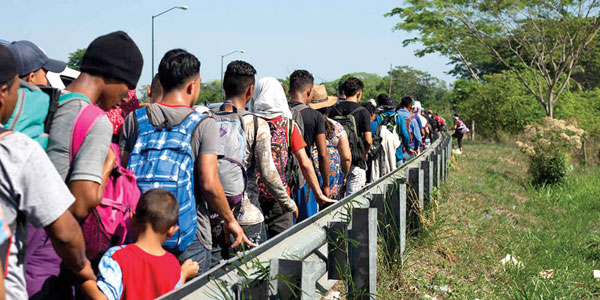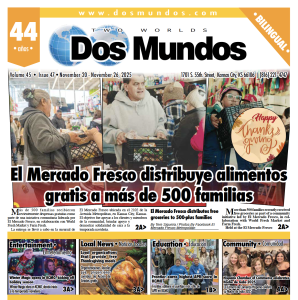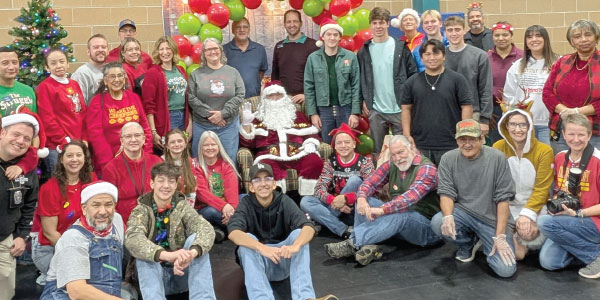
Mexico has become an incredibly dangerous place for Central American immigrants. The administration of President Andrés Manuel López Obrador has given in to the demands of President Donald Trump, and tens of thousands of migrants who are seeking asylum in the United States have been forced to wait in Mexico while their applications are processed in American courts.
The situation is terrible: At the makeshift migrant camps set up along the border, children — who are neither allowed to attend school nor receive health care — are forced to sleep on the ground, even in the winter cold, and teenagers are vulnerable targets for criminal gangs. Here, in a country rife with drug cartels and human trafficking, Central American families must live like this for months.
And Mexico has agreed to all of it.
It’s painfully ironic that Mexico — a country that for decades has exported immigrants to the United States — has become the primary impediment to migrants heading north. Mexico must not allow itself to be used as a waiting room for the United States. Mexico’s limited state and federal budgets should be used to fight Mexican crime and poverty, not crush the dreams of people who only want to pass through on their way to safety and a new life.
Since the introduction of the Migrant Protection Protocols last January, the U.S. Department of Homeland Security has required approximately 50,000 asylum-seekers and other migrants to wait in Mexico, according to an October 2019 report by Human Rights First. Already there have been over 340 reported cases of rape, kidnapping, torture and other violent acts committed against these immigrants. This figure would likely be much higher if all such crimes were reported.
For Central Americans fleeing gang violence at home, it’s hard to imagine that life in the border cities of Matamoros or Nuevo Laredo in Tamaulipas state could be much of an improvement. And yet, as Human Rights First points out, the State Department sends asylum-seekers to Tamaulipas to wait even while labeling it a “Level 4” threat, the same designation it gives Afghanistan, Iraq and Syria. According to reports by the López Obrador administration, 790 people were killed in Tamaulipas between January and November 2019.
The last few years have been some of the most violent in Mexico’s modern history. It’s clear that the Mexican government is unable to protect even the lives of its own citizens. Despite this, many thousands of migrants have come, and now have no choice but to stop and wait. Turning back is not an option: Cubans and Venezuelans can’t return to the dictatorships they left behind, and for many Central Americans going home would be a death sentence.
Yamali Flores and Josué Cornejo are a couple from Honduras, with two young daughters and a teenage son. Recently they were forced to flee the violence in northern Mexico and enter the United States illegally. They were captured and sent back across the border to Matamoros.
“We were applying for asylum in Mexico, but we saw one of the bosses of the people who killed our aunt … and they broke into our home while we were asleep,” Cornejo told me last fall in an interview. “Then I told my wife that we had no choice … and that’s why we decided to cross the river.”
During the crossing, Cornejo took great pains to protect evidence he had collected of the danger his family faced in Honduras and Mexico from any water damage. It didn’t matter. The American authorities arrested them anyway.
Immigrants entering the United States with children were once allowed to stay, even without valid documents. Now it’s not so simple. This new policy is part of the Trump administration’s effort to significantly reduce the number of undocumented immigrants staying in the country. The Human Rights First report estimates that, according to a policy it calls illegal known as “metering,” 26,000 asylum applicants have been turned away at U.S. ports of entry.
When I asked Flores how the family felt about staying in Matamoros, she told me they were “afraid [and] nervous because of all the things we see happening here.”
Unfortunately, they still have a long wait ahead of them before they learn if they’ve been granted asylum in America. “Even if it takes eight months,” Flores said, “we’ll be here.”
The family doesn’t have legal representation or the money to hire a lawyer, which drastically reduces chances that their application will be approved. Flores says she sometimes cries at night. “It’s hard to see your children sleeping on the floor,” she told me.
Intentionally or not, Mexico is preventing the family from living in a safe place. And neither the López Obrador administration nor the state of Tamaulipas has the infrastructure or economic resources to take care of so many immigrants. The tensions created by this lack of resources, and by the xenophobia of some Mexicans, have flared into anti-immigrant protests, where demonstrators shout things like “Mexico for the Mexican people!”
Such abuse is unlikely to stop as more immigrants arrive.
On Skype, Flores and Cornejo introduce me to their children, David, Génesis and Ivonne. “We only want them to live,” Flores says. “To become adults.”
I asked what would happen to their children if they were sent back to Honduras. “They would all be killed,” their father said.
Migrants like these are stuck in an impossible situation. They can’t seek safety in the United States, where they will only be turned away. Neither can they return to Central America, where they will face death. Instead, they must await their fate in violence-plagued northern Mexico.
Something must be done to help people like Flores and Cornejo and their children. And now.
______________________________________________________________________________________________
México, la Peligrosa Sala de Espera de Estados Unidos
Para los inmigrantes centroamericanos, México se ha convertido en una sala de espera para entrar a Estados Unidos increíblemente peligrosa. El gobierno del presidente Andrés Manuel López Obrador ha cedido ante las presiones del mandatario estadounidense, Donald Trump, y aceptó que Estados Unidos envíe a su territorio a decenas de miles de centroamericanos que están solicitando asilo político mientras se resuelven sus casos en los tribunales estadounidenses.
El resultado es terrible: carpas a la intemperie en la zona fronteriza de México, los niños —sin escuelas ni servicios médicos— duermen en el piso en pleno invierno, los adolescentes permanecen expuestos a grupos criminales y todos esperan por meses (o más) en un territorio amenazado por los cárteles de las drogas y traficantes de seres humanos.
Eso es lo que aceptó México.
Es irónico que México —un país que durante décadas fue exportador de inmigrantes al norte— ahora se ha convertido en el principal obstáculo para que muchos centroamericanos puedan llegar a Estados Unidos. México no debe ser la sala de espera de su vecino. Los limitados recursos estatales y el presupuesto federal deberían dedicarse a controlar el crimen que asola a México y reducir la pobreza, no a romper los sueños de personas que sólo quieren cruzar por su territorio.
Bajo el programa conocido como Quédate en México (o Migrant Protection Protocols), el Departamento de Seguridad Interna de Estados Unidos ha obligado a casi 50.000 solicitantes de asilo y a otros migrantes, sin importar desde dónde llegaron al país, a esperar en México, según el informe de Human Rights First. Y ya hay más de 340 casos reportados de violaciones, secuestro, tortura y otros actos violentos contra esos inmigrantes. A esta cantidad hay que sumar todos los casos que las víctimas no se atrevieron a reportar.
Para los centroamericanos que están huyendo de las pandillas y de la violencia es una locura pensar que, por ejemplo, Tamaulipas, un estado al norte de México, es un lugar seguro. No lo es. Muchos inmigrantes están siendo desplazados a las ciudades fronterizas de Matamoros y Nuevo Laredo. Es paradójico que, como señala Human Rights First, el mismo Departamento de Estado que ahora lleva a personas que piden asilo a Tamaulipas, considere que el nivel de peligrosidad del estado es “Nivel 4”, como el de Afganistán, Irak, Siria, Somalia o Yemen. Para no irnos más lejos, los informes del mismo gobierno de López Obrador reconocen que de enero a noviembre de 2019 asesinaron a 790 personas en Tamaulipas y que, aunque la violencia disminuyó respecto a 2018, sigue siendo un estado peligroso.
Los últimos años, los más violentos registrados en la historia moderna del país, han demostrado que el gobierno de México no puede garantizar la vida ni siquiera a los mexicanos. Y ahí es donde han caído miles de personas que han migrado, entre otras naciones, de Venezuela, Cuba o el Triángulo del Norte. No tienen más opción que esperar. Regresar a las dictaduras de Cuba o Venezuela es impensable. Y para muchos centroamericanos volver a sus países de origen podría significar la muerte.
Yamali Flores y Josué Cornejo son una pareja hondureña, con dos hijas pequeñas y un adolescente, y fueron forzados a regresar de Brownsville, Texas, a Matamoros, Tamaulipas. Vienen huyendo de la violencia.
“Estábamos en trámite de pedir asilo en México, pero vimos a uno de los jefes de las personas que mataron a una tía […] y se metieron a la casa mientras estábamos durmiendo”, me dijo Josué en una entrevista el otoño pasado. “Entonces le dije a mi esposa que aquí no había de otra […] y por eso decidimos cruzar el río” y llegar a Estados Unidos.
A pesar de que Josué había protegido del agua las “evidencias” del peligro al que estaban expuestos en Honduras y México, las autoridades estadounidenses los arrestaron —por haber cruzado ilegalmente— y luego regresaron a los cinco a México.
Esto es relativamente nuevo: entrar con niños y sin documentos válidos a Estados Unidos ya no es una garantía para poderse quedar. Todo forma parte de las nuevas medidas del gobierno de Trump, que han logrado reducir significativamente el número de inmigrantes indocumentados que se quedan en el país. El informe de Human Rights First calculó que se les ha negado el ingreso a Estados Unidos en los puertos de entrada a 26.000 solicitantes de asilo debido a una medida conocida como “metering” (o cuentagotas) que esta organización considera ilegal.
“¿Cómo se sienten en Matamoros?”, le pregunté a Yamali. “Nos sentimos asustados, angustiados de ver muchas cosas que pasan aquí. Y tenemos que seguir esperando mucho más todavía para poder lograr el asilo en Estados Unidos […]. No importa si son ocho meses. Aquí vamos a estar”.
Ellos no tienen un abogado que los represente ni el dinero para contratar a uno. Eso reduce enormemente las posibilidades de que su caso sea aprobado. Yamali me asegura que llora algunas noches. “Es difícil ver a nuestros hijos durmiendo en el suelo”.
México, conscientemente o no, le está quitando a la familia de Yamali y Josué la posibilidad de vivir en un lugar seguro. Además, ni el gobierno de López Obrador ni el estado de Tamaulipas parecen tener la capacidad económica y estructural para atender apropiadamente a tantos inmigrantes. Esto, y las expresiones xenofóbicas de algunos mexicanos —como las marchas en las que los manifestantes gritaron “fuera los maras” o “México para los mexicanos”—, auguran más tensiones y más abusos para los inmigrantes que son reubicados en México.
A través de una pantalla en Skype, Yamali y Josué me presentaron a sus hijos, David, Génesis e Ivonne. “Nosotros sólo queremos que ellos sigan viviendo”, comentó su madre, “que lleguen a ser adultos”.
Les pregunté qué pasaría si regresan a sus hijos a Honduras. “Los matarían a todos”, dijo el padre.
La situación es crítica para los migrantes centroamericanos. No pueden alcanzar la seguridad en Estados Unidos, pues este país sigue regresando a miles de inmigrantes a México. Tampoco pueden regresar a sus países de origen, donde sólo encontrarían la muerte. Entonces, deben esperar en algunas de las zonas más peligrosas del territorio norte de México.
Algo debe hacerse para ayudar a Yamali, Josué y sus hijos, pero debe hacerse ya.










